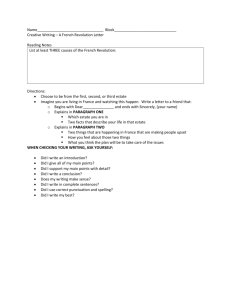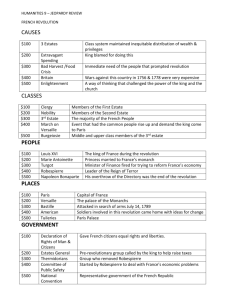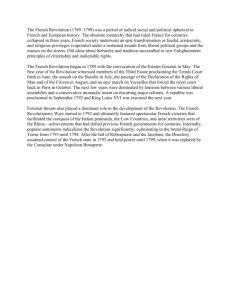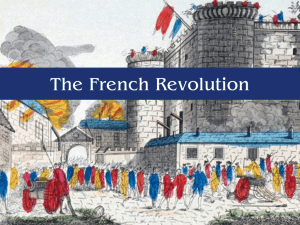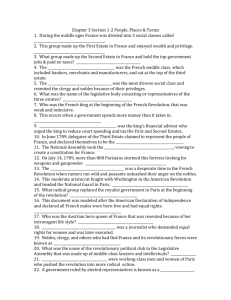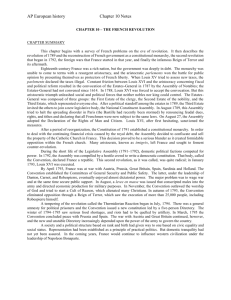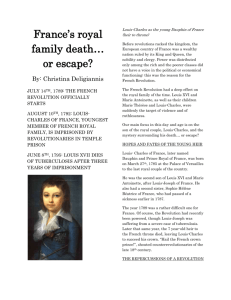I. Introduction to the French Revolution
advertisement
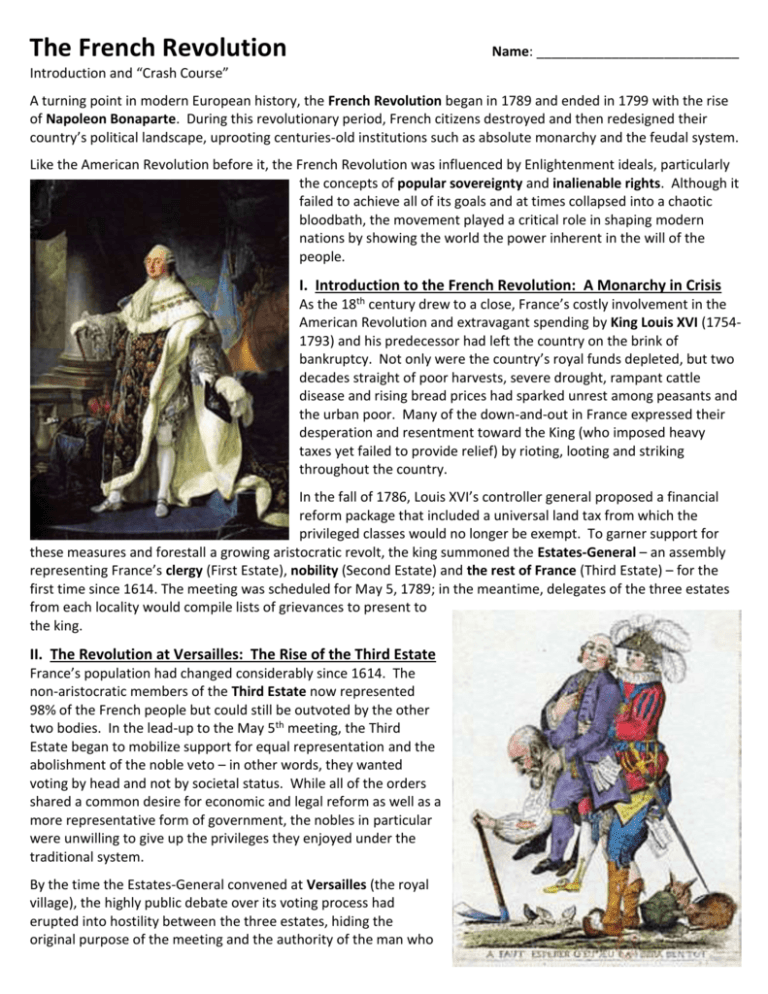
The French Revolution Name: ___________________________ Introduction and “Crash Course” A turning point in modern European history, the French Revolution began in 1789 and ended in 1799 with the rise of Napoleon Bonaparte. During this revolutionary period, French citizens destroyed and then redesigned their country’s political landscape, uprooting centuries-old institutions such as absolute monarchy and the feudal system. Like the American Revolution before it, the French Revolution was influenced by Enlightenment ideals, particularly the concepts of popular sovereignty and inalienable rights. Although it failed to achieve all of its goals and at times collapsed into a chaotic bloodbath, the movement played a critical role in shaping modern nations by showing the world the power inherent in the will of the people. I. Introduction to the French Revolution: A Monarchy in Crisis As the 18th century drew to a close, France’s costly involvement in the American Revolution and extravagant spending by King Louis XVI (17541793) and his predecessor had left the country on the brink of bankruptcy. Not only were the country’s royal funds depleted, but two decades straight of poor harvests, severe drought, rampant cattle disease and rising bread prices had sparked unrest among peasants and the urban poor. Many of the down-and-out in France expressed their desperation and resentment toward the King (who imposed heavy taxes yet failed to provide relief) by rioting, looting and striking throughout the country. In the fall of 1786, Louis XVI’s controller general proposed a financial reform package that included a universal land tax from which the privileged classes would no longer be exempt. To garner support for these measures and forestall a growing aristocratic revolt, the king summoned the Estates-General – an assembly representing France’s clergy (First Estate), nobility (Second Estate) and the rest of France (Third Estate) – for the first time since 1614. The meeting was scheduled for May 5, 1789; in the meantime, delegates of the three estates from each locality would compile lists of grievances to present to the king. II. The Revolution at Versailles: The Rise of the Third Estate France’s population had changed considerably since 1614. The non-aristocratic members of the Third Estate now represented 98% of the French people but could still be outvoted by the other two bodies. In the lead-up to the May 5th meeting, the Third Estate began to mobilize support for equal representation and the abolishment of the noble veto – in other words, they wanted voting by head and not by societal status. While all of the orders shared a common desire for economic and legal reform as well as a more representative form of government, the nobles in particular were unwilling to give up the privileges they enjoyed under the traditional system. By the time the Estates-General convened at Versailles (the royal village), the highly public debate over its voting process had erupted into hostility between the three estates, hiding the original purpose of the meeting and the authority of the man who had convened it. On June 17th, with talks over procedure stalled, the Third Estate met alone and formally adopted the title of National Assembly; three days later, they met in a nearby indoor tennis court and took the so-called Tennis Court Oath, vowing not to disperse until constitutional reform had been achieved. Within a week, most of the other two estates had joined them, and on June 27th, Louis XVI grudgingly absorbed all three orders into the new National Assembly. III. The French Revolution Begins: The Bastille and the Great Fear In June 1789, as the National Assembly continued to meet at Versailles, fear and violence consumed Paris. Though enthusiastic about the recent breakdown of royal power, Parisians grew panicked as rumors of an impending military coup d'état began to circulate. A popular rebellion climaxed on July 14th when rioters stormed the Bastille (a medieval fortress and prison in Paris that represented royal authority) in an attempt to secure gunpowder and weapons; many consider this event, now commemorated in France as a national holiday, as the start of the French Revolution. The wave of revolutionary passion and widespread panic quickly swept the French countryside. Revolting against years of exploitation, peasants looted and burned the homes of tax collectors, landlords and the French elite. Known as the Great Fear, the agricultural rebellion hastened the growing evacuation of nobles from the country and inspired the National Assembly to abolish feudalism in August 1789. IV. The French Revolution's Political Culture: Drafting a Constitution On August 4, the National Assembly adopted the Declaration of the Rights of Man and of the Citizen, a statement of democratic principles grounded in the philosophical and political ideas of the Enlightenment. The document proclaimed the Assembly’s commitment to replace the Monarchy with a system based on equal opportunity, freedom of speech, popular sovereignty and representative government. Drafting a formal constitution proved much more of a challenge for the National Assembly, which had the added burden of functioning as a legislature during harsh economic times. For months, its members wrestled with fundamental questions about the shape and expanse of France’s new political landscape. For instance, who would be responsible for electing delegates? Would the clergy owe allegiance to the Roman Catholic Church or the French government? Perhaps most importantly, how much authority would the king, his public image further weakened after a failed attempt to flee in June 1791, retain? Adopted on September 3, 1791, France’s first written constitution echoed the more moderate voices in the National Assembly, establishing a constitutional monarchy in which the king enjoyed royal veto power and the ability to appoint ministers. This compromise did not sit well with influential radicals like Maximilien de Robespierre, Camille Desmoulins and Georges Danton, who began drumming up popular support for a more republican form of government and the trial of Louis XVI. V. The French Revolution Turns Radical: Terror and Revolt In April 1792, the newly elected Legislative Assembly declared war on Austria and Prussia, where it believed that French exiles were building counter-revolutionary alliances; it also hoped to spread its revolutionary ideals across Europe through warfare. On the domestic front, meanwhile, the political crisis took a radical turn when a group of insurgents led by the extremist Jacobins attacked the royal residence in Paris and arrested the king on August 10, 1792. The following month, amid a wave of violence in which Parisian revolutionaries massacred hundreds of accused counterrevolutionaries, the Legislative Assembly was replaced by the National Convention, which proclaimed the abolition of the monarchy and the establishment of the French republic. On January 21, 1793, it sent King Louis XVI, condemned to death for high treason and crimes against the state, to the guillotine; his wife Marie-Antoinette suffered the same fate nine months later. Following the king’s execution, war with various European powers and intense divisions within the National Convention ushered the French Revolution into its most violent and turbulent phase. In June 1793, the Jacobins seized control of the National Convention from the more moderate Girondins and instituted a series of radical measures, including the establishment of a new calendar and the eradication of Christianity. They also unleashed the bloody Reign of Terror, a 10-month period in which suspected enemies of the revolution were guillotined by the thousands. Many of the killings were carried out under orders from Robespierre, who dominated the draconian Committee of Public Safety until his own execution on July 28, 1794. VI. The French Revolution Ends: Napoleon's Rise On August 22, 1795, the National Convention, composed largely of Girondins who had survived the Reign of Terror, approved a new constitution that created France’s first bicameral legislature. Executive power would lie in the hands of a five-member Directory appointed by French parliament. Royalists and Jacobins protested the new regime but were swiftly silenced by the army, now led by a young and successful general named Napoleon Bonaparte. The Directory’s four years in power were riddled with financial crises, popular discontent, inefficiency and, above all, political corruption. By the late 1790s, the directors relied almost entirely on the military to maintain their authority and had ceded much of their power to the generals in the field. On November 9, 1799, as frustration with their leadership reached a fever pitch, Bonaparte staged a coup d’état, abolishing the Directory and appointing himself France’s “first consul.” The event marked the end of the French Revolution and the beginning of the Napoleonic era, in which France would come to dominate much of continental Europe.
